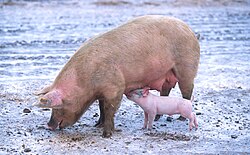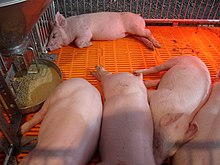This is an old revision of this page, as edited by 67.170.232.222 (talk) at 21:53, 30 June 2006. The present address (URL) is a permanent link to this revision, which may differ significantly from the current revision.
Revision as of 21:53, 30 June 2006 by 67.170.232.222 (talk)(diff) ← Previous revision | Latest revision (diff) | Newer revision → (diff) This article is about the broader pig genus. For the most familiar species, see domestic pig. For other senses of this term, see pig (disambiguation) or hog.- Sus redirects here; for the town in France, see Sus.
- Swine redirects here; it is also the German name for the Świna river.
| Pig and piglet | |
|---|---|

| |
| Domestic sow with piglet | |
| Scientific classification | |
| Kingdom: | Animalia |
| Phylum: | Chordata |
| Class: | Mammalia |
| Order: | Artiodactyla |
| Family: | Suidae |
| Genus: | Sus Linnaeus, 1758 |
| Species | |
|
Sus barbatus | |
Pigs are ungulates native to Eurasia collectively grouped under the genus Sus within the Suidae family. They have been domesticated and raised as livestock by some peoples for meat (called pork) as well as for leather. Their bristly hairs are also traditionally used for brushes. Wild pigs continue to fill these functions in certain parts of the world.
Pigs are omnivores, which means that they consume both plants and animals. On a small farm, or in a large household, they can be fed kitchen scraps as part or all of their diet. In the wild, they are foraging animals. Pigs that are allowed to forage may be watched by swineherds. Because of their foraging abilities and excellent sense of smell, they are used to find truffles in many European countries. They are also fattened to be eaten as ham and other types of meat, such as bacon.
Pigs are highly trainable animals, and some, such as the Asian pot-bellied pig, are kept as pets. A litter of piglets typically contains between 6 and 12 animals. Occasionally, in captivity, pigs may eat their own young.
Pigs lack sweat glands, thus they must have access to water or mud to cool themselves during hot weather. They also use mud as a form of sunscreen to protect their skin from sunburn.
Pig species

- Sus barbatus Bearded Pig; Malaysia, Indonesia
- Sus bucculentus Vietnamese Warty Pig
- Sus cebifrons Visayas Warty Pig
- Sus celebensis Celebes Warty Pig
- Sus daelius Poulter Warty Pig
- Sus heureni Flores Warty Pig
- Sus philippensis Philippine Warty Pig
- Sus salvanius Pigmy Hog; NE India, Himalayas
- Sus scrofa (also called S. domesticus) Domestic pig, razorback, wild boar; Europe, Asia
- Sus timoriensis Timor Warty Pig
- Sus verrucosus Javan pig, Warty Pig; Indonesia, Philippines
- Sus habeoncosus Malaysian pig, Warty Pig
Hybrid swine

Domestic Tamworth pigs are often crossed with wild boar to create "Iron Age Pigs" that resemble early domestic pigs. The piglets have stripes or blotches like young boar. "Iron Age Pigs" are a common attraction at farm parks. The hybrids are tamer than wild boar, but less tractable than domestic swine and generally become specialist pork sausages. Other domestic breeds of pig have been crossed with wild boar to produce a leaner meat for the specialist meat trade.
Various domestic pigs have been crossed with American wild hogs to produce compact, hairy hog-like hybrids.
In "The Variation Of Animals And Plants Under Domestication" Charles Darwin wrote: The European wild boar and the Chinese domesticated pig are almost certainly specifically distinct: Sir F. Darwin crossed a sow of the latter breed with a wild Alpine boar which had become extremely tame, but the young, though having half-domesticated blood in their veins, were "extremely wild in confinement", and would not eat swill like common English pigs.
Terminology

Several different words in English identify different types of pigs:
- Boar - An adult male pig
- Sow - An adult female pig
- Piglet/farrow - A juvenile pig
- Shoat - A young pig between 100 to 180 lb (50 to 90 kg)
- Gilt - An immature female pig
- Barrow - A castrated male pig
- Hog - a domestic or wild adult swine, especially one raised for slaughter because they fatten quickly; in its original sense it means a castrated boar.
- Swine - Synonym for "pigs" (plural)
As food
Meat from pigs is called pork (coming from the Latin words "porcinus" and "porcus"). Their trotters are often sold as the jelly-like dish of pig's feet. Hog jowls are a popular soul food. The American pig-raising industry calls pork a "white meat" (like poultry) implying it is healthier than "red meat" like beef. Both Islam and Judaism forbid the eating of pork in any form, considering the pig to be an unclean animal: no form of pig meat can be kosher or halal (see taboo food and drink)
Cultural references to pigs

Religious references
- In ancient Greece, a sow was an appropriate sacrifice to Demeter and had been her favorite animal since she had been the Great Goddess of archaic times. Initiates at the Eleusinian Mysteries began by sacrificing a pig.
- The pig is one of the 12-year cycle of animals which appear in the Chinese zodiac related to the Chinese calendar. Believers in Chinese astrology associate each animal with certain personality traits. See: Pig (Zodiac).
- Muslims are forbidden to consume pork by the Qur'an.
- Jews are also forbidden to consume pork by the laws of Kashrut.
- In the Gospels, Jesus tells a parable of a prodigal son who gets a job feeding pigs and wished that he could eat the swill himself.
- In the Gospels, Jesus performs a miracle by causing demons who possess a man to enter a herd of swine who then run off a cliff and drown.
Pigs and people
- Pigs are often used to comment on the human condition. Winston Churchill said that "Dogs look up to us. Cats look down on us. Pigs treat us as equals."
- A number of schools (elementary, middle, and high schools) and universities have adopted pig or pig-related mascots. The most notable of which are the University of Arkansas Razorbacks, whose mascot, the razorback (Sus scrofa) makes them the only university or major sports team in the United States with a porcine mascot.
- Magical transformation of humans into pigs has been used as a key plot device in fantasy storytelling - for example the Ancient Greek epic Odysseus, in which the hero's ship's crew is turned into pigs by Circe.
- Zhu Bajie is a famous part human, part pig, literary character from the Chinese novel Journey to the West.
Pig-related idioms
- The idiomatic phrase "when pigs fly" (or 'pigs might fly') refers to something that is unlikely to ever happen. Though its origins are much older, its popularity is reinforced by such popular references as in the Lewis Carroll poem The Walrus and the Carpenter and Pink Floyd's album Animals
- The English language abounds with unflattering references and idioms involving pigs. Pigs are commonly associated with greed ("as greedy as a pig") and obesity, gluttony ("to pig out"). Likewise, a hog is someone or something that monopolizes time, resources, or processes, e.g. a road hog or server hog. Pigs are also associated with dirtiness ("this room is a pigsty"); the latter probably comes from their habit of wallowing in mud. The perennially soot-covered character in the Peanuts comic strip is named Pig-Pen.
- "Pig" is also used as a derogatory slang term for a police officer in more than just the English language.
- "Male chauvinist pig" was a derogatory term adopted by the women's liberation movement in the 1960s to describe men who seem to believe that males are superior to females.
- "In a pig's eye" is a rhyming slang expression meaning, "That's not true." "Pig's eye" rhymes with, "lie."
- "Sweating like a Pig" to indicate sweating heavily. This is incorrect, as pigs don't have sweat glands.
- "Pig out" is an idiom that means to eat voraciously.
- The Missouri folklorist Max Hunter collected a number of pig-related idioms:
- "It's plain as a pig on a sofa"
- "Clumsy as a hog on ice"
- "Content as a dead pig in the sunshine"
- "Wild as a peach-orchard hog"
- Thrifty (if not fussy) sausage-makers were said to use "everything but the squeal."
- The term "slicker than a greased pig" refers an event that went well without any set backs.
Other pig-related words
- The noise that a pig makes is usually represented as "oink" in the English language but in many different ways in other languages – for instance, chrum (Polish), hunk (Albanian), hulu (Mandarin Chinese), nøff (Norwegian) and so on. See oink for a fuller list.
- American footballs were originally made from pig skin and are often called pigskins.
- The familiar piggybank got its name and shape as a result of a pun on the word pygg, a type of clay commonly used to produce household items in the 18th Century.
- Pig iron is so named because the molten newly-smelted iron was once poured into molds resembling rows of suckling pigs.
- A type of barrel called a "hog's head" appears often in the writings of Mark Twain.
- A "hogshead" is a large volume of liquid.
Music and art
- Song of Pig is a popular song in China.
- Pigs feature heavily in the artwork and stage shows of the rock band Pink Floyd.
- War Pigs is an anti-war song by the British heavy metal band Black Sabbath.
- There are scenes of Marilyn Manson riding a pig in the Sweet Dreams MTV.
- KMFDM contributor Raymond Watts has solo project called PIG.
- The industrial-rock band Nine Inch Nails have songs titled "March of the Pigs" and "Piggy", both on the album The Downward Spiral.
- Pigface is an industrial rock supergroup formed in 1990 by Martin Atkins and Bill Rieflin.
- Pink Floyd's 1977 album Animals featured three songs about pigs, in symbolic, Orwell referencing form. See the article for a wider analysis.
- Piggies is a song by Beatle George Harrison, comparing people to pigs.
- Pigs are a recurring motif in the work of Jhonen Vasquez
- Miss Piggy is an anthropomorphized, fictional character from The Muppet Show television series.
- Homer Simpson calls the pig a "wonderful, magical animal" in The Simpsons episode Lisa the Vegetarian, unaware that bacon, ham and pork chops are all from the same animal.
- An Elephant Makes Love to a Pig is an episode of South Park, in which the boys try to cross-breed Cartman's pig with Kyle's Elephant.
- The movie Razorback (film) is about a killer hog/razorback.
See also
- Family farm hog pen
- Bacon
- Ham
- Hog-baiting
- Guinea pig (is a rodent)
- Intensive pig farming
- Razorbacks (mascot for the sports teams of the University of Arkansas, also known as "The Hogs")
- List of fictional pigs
- Pig iron
- Pigpen
- Pig War
- Fetal pig
- Hogzilla
- Pig Olympics